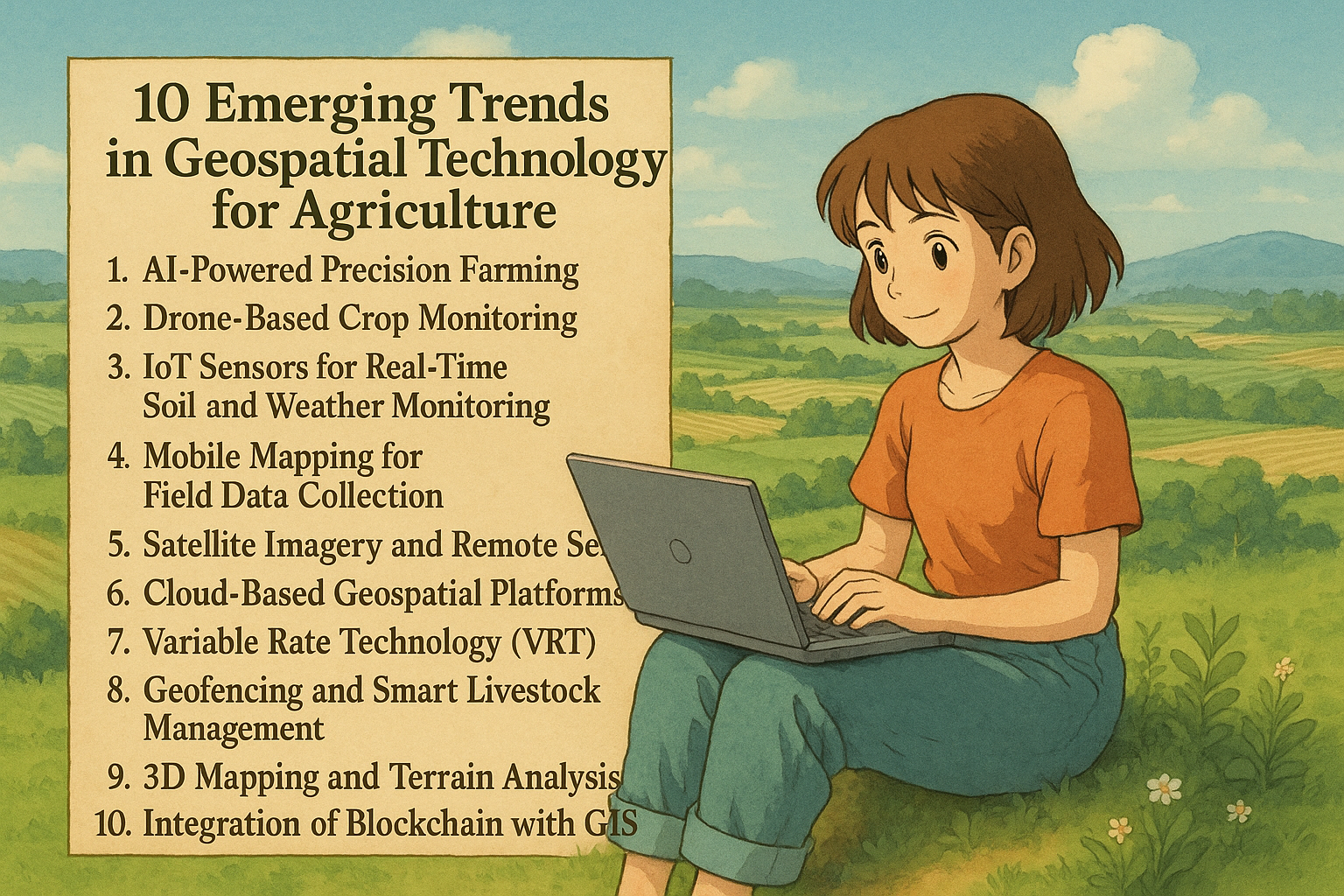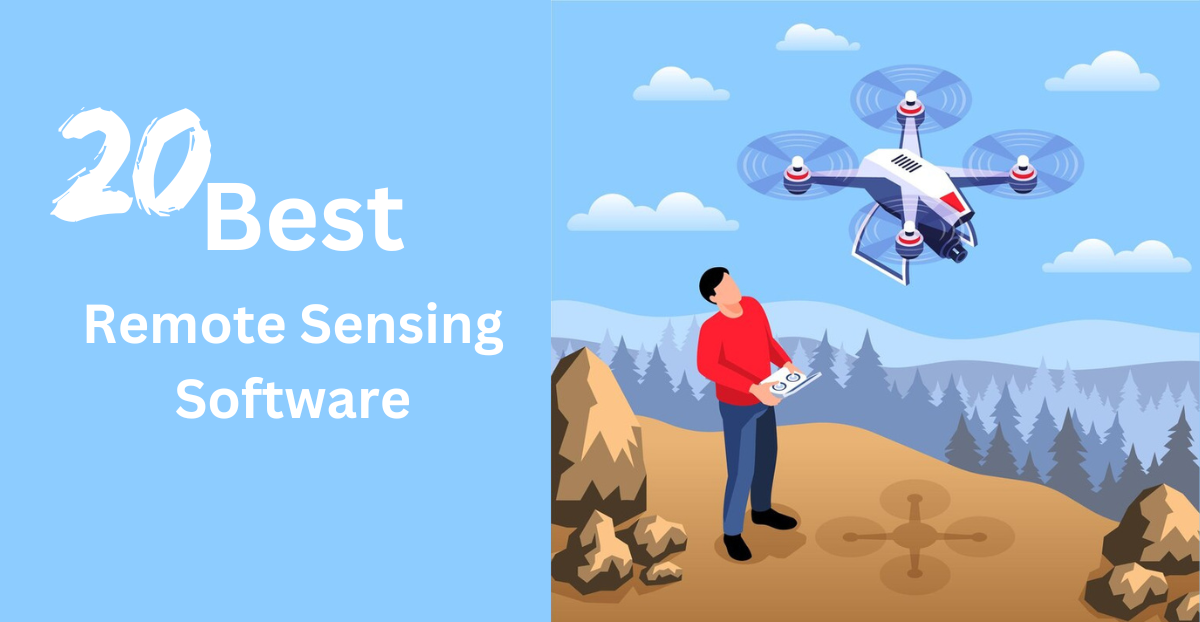10 Emerging Trends in Geospatial Technology for Agriculture
In the age of smart farming, geospatial technology is transforming how we grow food and manage land. With the integration of GIS (Geographic Information Systems), AI (Artificial Intelligence), drones, mobile mapping, and the Internet of Things (IoT), agriculture is becoming more efficient, sustainable, and data-driven. This blog explores 10 emerging trends in geospatial technology for agriculture that are shaping the future of food production. 10 Emerging Trends in Geospatial Technology 1. AI-Powered Precision Farming Artificial Intelligence (AI) is at the forefront of the precision agriculture revolution, enabling farmers to make data-driven decisions with remarkable speed and accuracy. By leveraging machine learning algorithms, AI systems can process vast amounts of data collected from satellites, drones, sensors, and farm equipment. One of the key benefits of AI in agriculture is its ability to analyze real-time data such as weather patterns, soil composition, crop health indicators, and historical yield records. This data is then used to generate actionable insights that help farmers: Predict crop yields more accurately Identify and prevent pest infestations or crop diseases before they spread Optimize irrigation schedules and nutrient application Reduce input waste (fertilizer, water, pesticides) while maximizing outputs When integrated with Geographic Information Systems (GIS), AI becomes even more powerful. AI and GIS integration allows farmers to visualize spatial data through interactive maps, identify problem zones in specific fields, and apply resources only where needed—minimizing costs and environmental impact. For example, AI models can detect subtle changes in plant coloration from satellite or drone imagery to flag early signs of crop stress. Combined with GPS-enabled machinery, this allows for targeted interventions down to the square meter. In addition, AI is also being used in automated machinery like self-driving tractors and smart harvesters, further advancing precision farming techniques. As agricultural challenges grow—ranging from climate change to population pressure—AI-powered precision farming is becoming essential for sustainability, profitability, and global food security. Keyword Focus: AI in agriculture, precision farming, AI and GIS integration, smart farming with AI, AI crop prediction, geospatial AI agriculture 2. Drone-Based Crop Monitoring The use of drones in agriculture has rapidly evolved from a novelty to a necessity. These Unmanned Aerial Vehicles (UAVs) are now essential tools for modern precision farming, offering a fast, efficient, and highly accurate way to monitor large agricultural fields. Equipped with multispectral, hyperspectral, and thermal sensors, crop monitoring drones can capture detailed aerial imagery that the human eye simply cannot detect from the ground. These high-resolution images help farmers observe: Plant health and stress through vegetation indices like NDVI (Normalized Difference Vegetation Index) Water distribution to identify over- or under-irrigated areas Pest infestations and disease outbreaks at an early stage Crop emergence and growth uniformity across different field zones Storm or drought damage assessment in real-time Drones provide frequent and flexible data collection, allowing farmers to monitor crops at any growth stage and respond quickly to issues. This is particularly useful in large-scale farming operations where traditional scouting methods are labor-intensive and time-consuming. In addition to monitoring, some drones are now used for precision spraying of pesticides and fertilizers. These spraying drones reduce chemical usage by applying inputs only where needed, improving environmental safety and lowering operational costs. Another major benefit of UAV mapping is the ability to generate 3D terrain models and orthomosaic maps of fields. These maps assist in planning irrigation systems, analyzing drainage, and managing soil erosion—all critical factors for sustainable farming. With advancements in AI and automation, the future of drone-based agriculture looks even more promising. Autonomous drone fleets, real-time AI analysis, and live data streaming are just a few innovations on the horizon. Keyword Focus: drones in agriculture, crop monitoring drones, UAV mapping, drone crop health analysis, drone farming technology, precision agriculture drones 3. IoT Sensors for Real-Time Soil and Weather Monitoring The Internet of Things (IoT) is revolutionizing smart agriculture by enabling real-time data collection from fields through interconnected sensors and devices. These IoT in farming systems provide farmers with continuous, accurate, and location-specific information about their crops, soil, and environmental conditions. IoT sensors can be deployed across farmlands to monitor crucial variables such as: Soil moisture levels to prevent over- or under-irrigation Soil temperature to determine optimal planting and harvesting times Ambient temperature and humidity for better pest and disease control Rainfall and weather patterns for forecasting and planning field activities When this data is integrated with GIS platforms, it becomes even more powerful. GIS allows farmers to visualize sensor data on digital maps, identify patterns, and make precise, field-specific decisions. For example, a farmer can set up an automated irrigation system that responds to real-time soil moisture readings, reducing water waste and improving crop health. This form of real-time soil monitoring helps in: Smart irrigation management—watering only where and when needed Fertilizer application optimization based on soil nutrient data Early warning systems for drought, frost, or extreme weather events Efficient resource planning and reducing environmental impact The integration of IoT in farming is also paving the way for predictive analytics, where collected data is used to model future scenarios—such as expected yields or pest outbreaks—enabling proactive farm management. As 5G networks and cloud-based analytics continue to grow, IoT applications in agriculture will become faster, more reliable, and more scalable, even for small and medium-sized farms. Keyword Focus: IoT in farming, smart agriculture, real-time soil monitoring, IoT sensors for irrigation, agricultural weather sensors, precision farming with IoT 4. Mobile Mapping for Field Data Collection With the rise of smartphones and tablets equipped with built-in GPS, mobile mapping has become an essential tool in modern agriculture. Using mobile GIS apps, farmers, agronomists, and field technicians can now collect, edit, and analyze georeferenced data directly from the field—without the need for expensive or bulky equipment. This approach to field data collection using GIS enables real-time decision-making, enhances data accuracy, and reduces delays between observation and action. Users can: Mark field boundaries or specific problem areas Record observations such as pest infestations, crop diseases, or irrigation issues Capture geotagged photos and notes for later analysis Upload data … Read more

